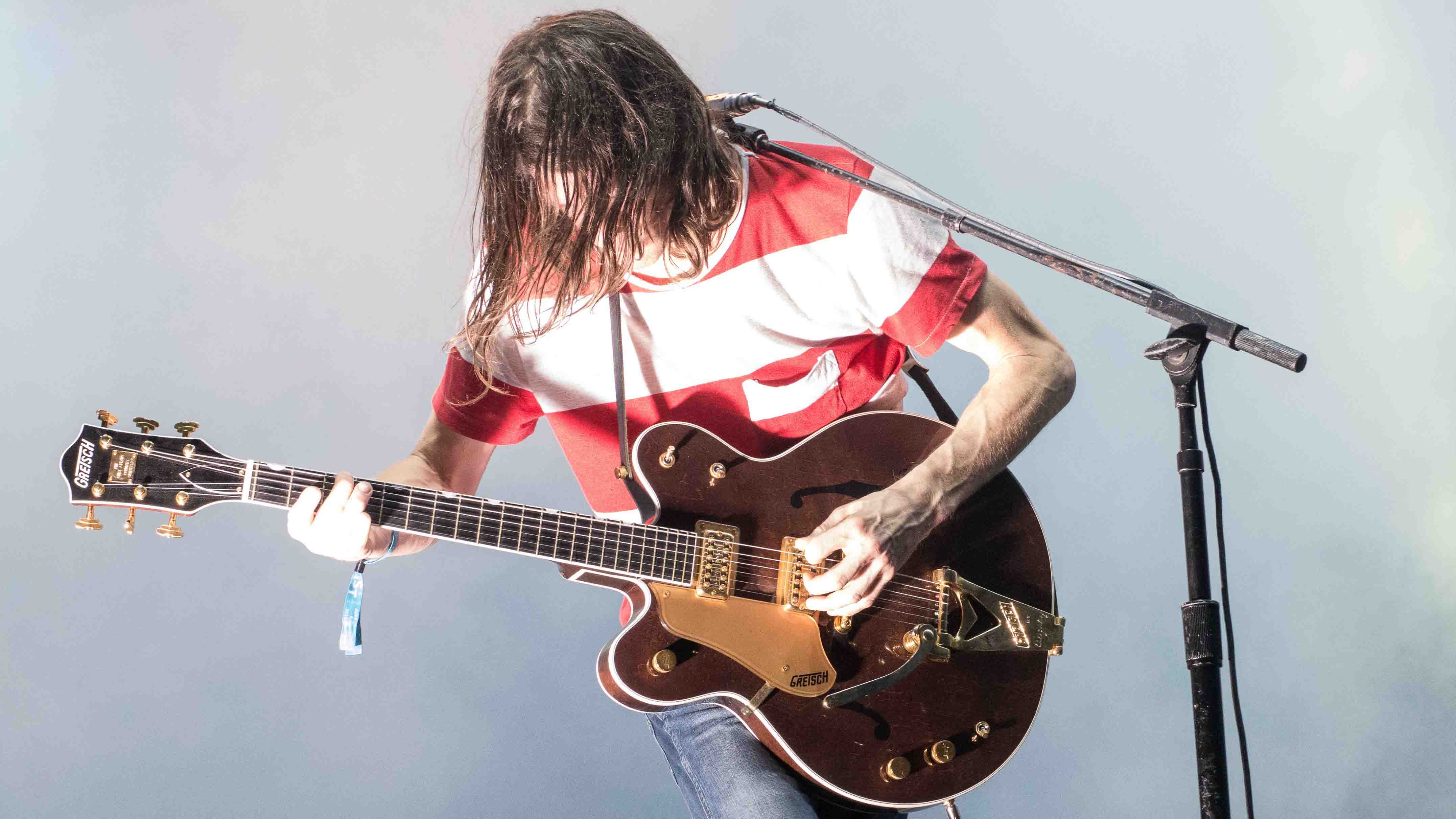The Black Angels talk fuzz selection, Phil Ek and crafting Death Song
Guitarist Christian Bland on the psychedelic band’s fifth album

Death Song
In fifth album Death Song, Austin psych-rockers The Black Angels are channelling a cracked American dream.
A Trump-bronzed, black-mirrored reflection of summer of love influences, it ponders the West’s passionate, indulgent affair with the economic game of chance, all through the prism of irresistible fuzz tones and some screeching lead work, courtesy of lead guitarist and founder member Christian Bland.
Currency predicts the end of the money-death cycle in cleansing apocalypse, Half Believing is a hair-raising sermon on faltering faith in the people you hold dear, while Estimate combines a marching catharsis and baroque melody, while the line “I would love to stay here in this town/ but they’ve poisoned the water” nods to the recent crisis in Flint, Michigan.
We spoke to Christian about the record’s troubled origins, sharing childhood in Texas with frontman Alex Maas and why he needs four fuzzes on his pedalboard at any one time.
The band was formed by yourself and vocalist/bassist Alex Maas. How did you first meet Alex?
“I met Alex when I was 13 years old. He came to the church that my dad was a preacher at, through mutual friends, the Diaz family. We figured out that he and I were creative and we started to create stuff together, but we didn’t start off playing music.
“I didn’t start playing guitar until I was 20 years old, but we always knew that we enjoyed each other’s creativity, and when we got together we would always create stuff and we would always have fun together.
“The church always had youth group and we would go downtown to Houston and - you know that Zombies song Time Of The Season? [Sings] ‘Boom, boom, boom, tik-kussh’ We started [doing things like] leading the entire group doing what I just did. We made the entire group do different parts of the song.”
When did psychedelic music enter your life?
One day, in 1968, my dad walked into a record shop and bought Sgt. Pepper’s and he kept it. Little did he know how much of an impact that would have on me
“I discovered my dad’s Sgt. Pepper’s… record when I was like 10 years old, and then that just opened the doorway to that kind of music and there was no turning back.
“My parents always listened to this channel on the radio called Oldies 94.5, so I just grew up listening to Oldies, and Alex did, too. His parents showed him The Beatles, and that was just another thing that we always enjoyed together.
“It’s pretty crazy: one day, in 1968, my dad walked into a record shop and bought Sgt. Pepper’s and he kept it. Little did he know how much of an impact that would have on me. The day he went to go buy that record, he changed his son’s life!”
You didn’t learn guitar until you were 20. What made you pick it up then?
“When I was 12 years old, I tried to learn how to play, but I couldn’t figure it out. I felt like my hands weren’t big enough, and I’m left-handed and my dad’s guitar was right-handed, so I couldn’t figure out for the life of me what was going on.
“Then I got a scholarship in high school to do high jump in track and field, and high jump became my passion. Then one season I broke my ankle and I had to sit out and that’s when I tried to learn how to play guitar again. This time, I figured out that you could flip the guitar upside down and string it for a left-handed person, and all of a sudden it just started making sense.
The guitar was like instantaneous creativity. Right when you’re thinking it, boom! You’re creating it
“After that, there was no turning back: a whole new world was opening for me and it was amazing. I studied advertising and graphic design in college and it’s a slower creative process, but the guitar was like instantaneous creativity. Right when you’re thinking it, boom! You’re creating it.”
It’s interesting that it came so late. As an outsider, you assume that any teenager who’s growing up within striking distance of Austin is issued a psych-rock band as soon as he/she turns 13…
“Oh yeah, that’s how it is! You get your Zombies album standard issue, Sgt. Pepper’s, Velvet Underground… [laughs]”
You came to it quite late, so you probably had a good idea of the music you wanted to make at that point. What kind of music were you inspired by during that time?
“I always enjoyed watching Live At Pompeii and watching David Gilmour. When I was first learning guitar, I would study Beatles songs and Velvet Underground songs, from the first album. Learning the songs off The Velvet Underground And Nico, it was cool for me to see that the songs on that record didn’t have all that many chords, but they were put together so well, so it was pretty inspirational.
“Any time that somebody asks me the best way to learn how to play the guitar, I tell them that it’s to learn the songs that inspire you, to figure out how those songs came about. I think Syd Barrett is probably my favourite player, because he was a painter first, but he painted with his guitar. It's like he was painting sounds. I’m very inspired by that.”

Hot fuzz
What’s your main guitar, amp and FX?
“I use a lot of echo. I’m a huge fan of echo and reverb. But if I had to choose three effects, it would be echo, fuzz and a wah pedal. My main guitar is a 345 Rickenbacker. The reason for my love of Rickenbackers is John Lennon.
“My favourite amp is a Fender Twin Reverb ’65 Blackface reissue. Early on I kept the speakers that came with it, but I used to fry out the speakers too much, so I had to get 80-watt Celestion speakers in it to handle the fuzz. Then my pedals would be a Fulltone Tape Echo, my old Vox wah pedal, a V846, which is from 1968, then my Analogman Peppermint Fuzz is my favourite fuzz.”
You’re something of a fuzz connoisseur. What do you look for in a fuzz pedal?
“I have several fuzzes on my board, because they all sound different. I like Analogman a lot, so I have two Fuzz Face-[style pedals]: one is the BC108 Silicone Sun Face, which is like the blue Fuzz Face that David Gilmour has on Live At Pompeii, then I have the NKT275, which is like the original first Fuzz Face.
“So I have both those and then the Peppermint Fuzz, and then I also have this thing called the Bumble Fuzz, which is like the Jack White pedal. It’s the loudest fuzz I’ve ever heard in my life. The Peppermint is my favourite. It’s called that is because of that Strawberry Alarm Clock song, Incense And Peppermints - the fuzz at the end of that song, that’s how that fuzz sounds. It’s great.”
Rickenbacker seems to be one of those brands that's quite divisive among collectors. What's your experience?
“I love it. The combination I’ve found with the Fender Twin Reverb and the Rickenbacker is amazing. Another fuzz I have on my board - I forgot to tell you - is this old Russian Big Muff, but if I play any other guitar besides the Rickenbacker with the Twin and Big Muff, it sounds like shit, but with the Rickenbacker it’s a magical thing. But you can’t reveal that to anybody… Just kidding. But it’s always the combo of things that I’m looking for.”

"A manual for living"
Production on Death Song was handled by Phil Ek (Father John Misty, Fleet Foxes, The Shins). There’s always a sense of un-ironed, natural clarity in his work. What do you put that down to?
“I loved working with him. He worked exactly like The Black Angels like to work. We always record together live, and we always prefer to at least be able to see each other when we’re recording live.
“He would tell us to set our amps ‘exactly how you want it, set your pedals exactly how you do it’, so we would set everything and everything was done beforehand. He preferred not to have to EQ things afterwards. It was all done from the get-go, instead of being like, ‘Nah! We’ll fix that later!’ It was, ‘No, we’ll fix that right now and we do it how we want it to sound.’ I really appreciated that approach. It was not relying on doing it later, it was getting it right, immediately.”
Death Song is described as “a troubled record for troubled times”. How would you describe the mood of the band during the writing?
“The record was written over a period of three years, so the moods changed over three years. We’re observers, I guess. We take note of what happens. We weren’t negative or positive, we were just reporting what we saw - and the US is always a troubled place! Even prior to Trump coming in.
“Things aren’t that great here. It’s always troubled times in the United State of America, so it’s always very easy to write a troubled album. The world’s not a perfect place. With Trump, I mean, I’ve almost tried to pretend that he’s not in the presidency. For the most part, I try to not even think about that.”
Finally, the band are named for The Velvet Underground’s Black Angel’s Death Song. Why did it feel appropriate to close the loop with this record’s title?
“It seemed like it fit the record as well. The idea of the Death Song is from Orwell’s 1984, you know, ‘freedom is slavery, war is peace’, it all means the opposite of what they’re talking about, so ‘death song’ to me is ‘life song’ - and that’s why the last song on the record is called Life Song. I feel like the record, if you were to give it to somebody at random, [although it’s called Death Song], really, it’s a manual for living.”
Death Song is out now.
Matt is a freelance journalist who has spent the last decade interviewing musicians for the likes of Total Guitar, Guitarist, Guitar World, MusicRadar, NME.com, DJ Mag and Electronic Sound. In 2020, he launched CreativeMoney.co.uk, which aims to share the ideas that make creative lifestyles more sustainable. He plays guitar, but should not be allowed near your delay pedals.
